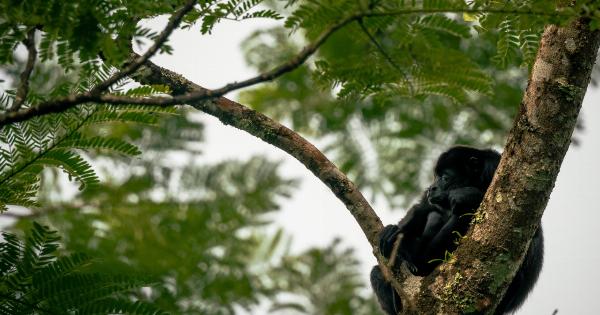Monkeying Around: 78 Outbreaks on the Plain.
Monkeys are fascinating creatures. With their playful antics and human-like behaviors, it’s hard not to be captivated by these intelligent primates.
However, there is another side to monkeys that often goes unnoticed – their potential to spread diseases. In fact, there have been 78 recorded outbreaks linked to monkeys in various parts of the world.
In this article, we will explore these outbreaks and delve into the reasons behind them, shedding light on the importance of understanding the risks associated with monkey encounters.
1. Monkeypox: A Growing Concern
Monkeypox, a rare viral disease, has been responsible for several outbreaks in recent years. It is believed to have originated from African rodents but can be transmitted to primates, including monkeys, and then onto humans.
The symptoms of monkeypox closely resemble those of smallpox, with fever, rash, and blister-like lesions being the most common. The outbreaks have raised concerns about the potential for this disease to become a global health threat.
2. Simian Immunodeficiency Virus (SIV)
Similar to the human immunodeficiency virus (HIV), Simian Immunodeficiency Virus (SIV) can infect monkeys and apes.
While SIV does not typically cause severe disease in its natural hosts, it can jump species barriers and infect humans, leading to a new strain called HIV. Understanding the transmission dynamics of SIV and its potential for cross-species transmission can help prevent future outbreaks of HIV-like diseases.
3. Monkey Bites and Zoonotic Infections
Monkey bites can result in zoonotic infections, where a disease is transmitted from animals to humans.
Several bacteria and viruses can be transmitted through monkey bites, including Herpes B virus, which can cause severe neurological damage if left untreated. Proper precautions, such as avoiding contact with wild monkeys and ensuring appropriate wound care, are essential to prevent zoonotic infections resulting from monkey bites.
4. Parasitic Infections: Monkey-Borne Malaria
Malaria, a life-threatening disease caused by Plasmodium parasites, is known to be transmitted by mosquitoes.
However, certain monkeys can carry the parasites and act as reservoirs, contributing to the spread of malaria in areas where monkeys and humans coexist. Understanding the role of monkeys in malaria transmission can help develop more effective control strategies.
5. Monkey Meat: A Source of Infection
In some regions, monkeys are hunted for their meat, which can pose health risks to humans. Consumption of undercooked or improperly handled monkey meat can lead to various infections, including viral hemorrhagic fevers like Ebola and Marburg.
Strict regulations and awareness campaigns are necessary to minimize the risk of infection through the consumption of monkey meat.
6. Monkey Exports and Disease Outbreaks
The global trade in monkeys, driven by the demand for research, pets, and entertainment, has contributed to disease outbreaks.
Monkeys exported from their natural habitats are often subjected to stressful conditions, compromising their immune systems and making them more susceptible to infections. This, in turn, increases the likelihood of disease transmission to humans who come into contact with them.
7. Monkey Temple Syndrome
In certain parts of the world, monkeys are considered sacred and are housed in temples. While these temples attract tourists, they also harbor potential risks.
The close interactions between monkeys and humans in these settings create opportunities for disease transmission. Outbreaks of bacterial and viral infections have been observed in such temples, emphasizing the need for proper management and visitor education.
8. Monkey Tourism and Disease Exposure
Monkey tourism, where tourists have close encounters with monkeys in natural habitats, has gained popularity. While it offers a unique experience, it also comes with risks. Direct contact with monkeys can result in injuries and disease transmission.
Education of tourists, enforcement of proper guidelines, and responsible tourism practices can minimize the risks associated with monkey tourism.
9. Monkey Rescues and Disease Control
Monkey rescues and sanctuaries play a crucial role in protecting and rehabilitating primates. However, these facilities can become hotspots for disease transmission if proper quarantine and disease control measures are not in place.
Adequate training and resources should be provided to ensure the safety of both rescued monkeys and the humans involved in their care.
10. Conservation Efforts and Disease Management
Conservation efforts are essential for preserving monkey populations and their habitats. These efforts should go hand in hand with disease management strategies, as healthy monkey populations are less likely to harbor and spread diseases.
By understanding and addressing the factors contributing to disease outbreaks, conservationists can promote the coexistence of humans and monkeys while minimizing health risks.
Conclusion
While monkeys may appear harmless and delightful, they can be significant carriers and transmitters of diseases.
The 78 outbreaks linked to monkeys serve as a reminder that interactions with primates, whether in the wild or captivity, carry potential health risks. Employing preventive measures, such as promoting awareness, implementing proper guidelines, and supporting research and conservation efforts, is crucial for ensuring the well-being of both humans and monkeys.






























